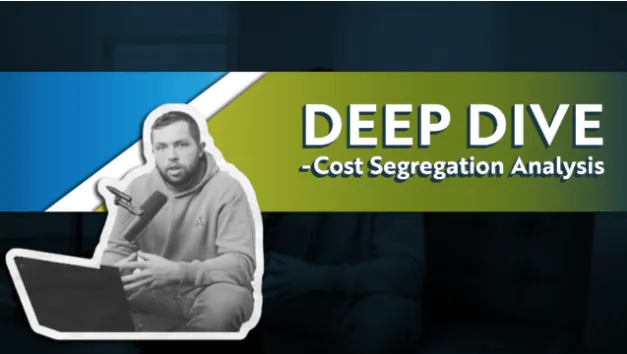Latest blogs and articles
Leading you to a better financial future.

Deep Dive- Cost Segregation Studies
Deep Dive- Cost Segregation Studies
Cost Segregation Study
If you own rental real estate then you should know about cost segregation studies. Keep reading for what this study is, how it works, and who benefits.
You can think of a cost segregation study like accelerating a loan from the IRS. Sounds crazy, right! Here’s what you need to know. Doing a cost segregation study will allow a significant amount of depreciation to be taken in the earlier years of the study. This means that you will speed up your tax benefits, and your taxable income will go down, meaning more money in your pockets.For more information about depreciation check out earlier podcasts. Choosing this method has its very clear advantages, however, there are important points to consider. Heavy depreciation will lower the cost basis for the property which will be recaptured when it’s time to sell. This is why cost segregation can be considered a loan. Because at one point you do have to pay it back.
This being said, utilizing a tax strategy requires planning. It is not a one size fits all strategy. How do you know it's right for you? Here are a couple of signals that a cost segregation study might be right for you.
1. High tax bracket
A simple google search will show what tax bracket you are currently in. If your bracket is over 24%, this is a good sign that a cost segregation study could be beneficial to you. Higher tax brackets mean higher savings with depreciating properties.
2. Significant rental income
If you have a lot of rental income, a cost segregation study will significantly decrease your tax due; this is especially true if you are running out of deductions to take with your other properties.
3. Recently sold properties
Having recently sold properties will oftentimes generate significant gains. That could mean that it is a prime year for substantial depreciation. Depreciation from the cost-segregation studies will offset these gains.
4. Purchase prices over $350,000
Large properties see more benefit from cost segregation studies because of their significant value. A good breaking point for this is $350,000. This is where the benefits begin to outweigh the costs. Can they be done on properties cheaper than $350,000? Yes. At which point I would recommend looking into a DIY Cost Seg Company.
5. Material Participation
If you are able to materially participate in your property, then a study could likely be beneficial.
On the other side of the coin, sometimes cost segregation studies can be inefficient or even harmful in the wrong circumstances. Here are a few of those scenarios.
1. Lower tax brackets
On the flip side, if you are in a year with a lower tax bracket, the increased depreciation will do little to decrease taxable income. It would be better to wait and do the cost segregation study in a later year when we are over the 24% threshold.
2. Little to no rental Income
Like above, less rental income will not see the same advantage of heavy depreciation.
3. High land to building value
Cost segregation on properties where the land has a substantial amount of the value defeats the purpose of a cost segregation study. Land is not depreciated, but the buildings are. Cost segregation on a property like this will won’t see much benefit
4. Short term properties
If selling the property is a goal of the near future, cost segregation has no point because the recapture will occur at the sale.
The essence of this method boils down to the time value of money. A dollar today is worth more than a dollar tomorrow. Using savings made today will produce more income for the future. This income is what is used to pay the tax bill down the road.
If you like the idea of a cost segregation study, great! But there are still a few questions that are in the air. Let's look at a few.
Does this make sense to do on a property you didn’t pay a lot for?
This can be answered by looking at the signals above. For example, if the property has a high building to land ratio, then this strategy can still make a lot of sense. Just because the property didn’t cost an arm and a leg doesn’t mean a cost segregation study is a bad idea.
When does the study need to be done?
This study needs to be done before you file your taxes. However, the sooner the better. If you can get accurate numbers to your accountant earlier, you will get more detailed calculations for your return.
Can I do this on a property I already own?
Yes! Cost segregation studies do not need to be done in the first year. If you are already a real estate investor and this is something new, you could still participate.
Here is what to watch out for. First, be careful with a cost segregation study on a DSCR loan property. You might get hit with the prepayment penalty and the depreciation recapture tax in one year. This happens if you sell within a certain time frame - typically five years. In this scenario, it is important to buy out the prepayment penalty upfront. Second, doing a study on a property in a restrictive area like a HOA, Community can cause some issues down the road. If the rules change, you could be forced to sell and you will have to pay back the recapture.
A cost segregation study is like many of the tax strategies we talk about on the LeanlikeaCPA show. It can be very advantageous, but only when implemented correctly. The first step is to understand the strategy and then use it to plan around taxable events. Using cost segregation in conjunction with other tax strategies like exiting tax efficiently can save thousands or even hundreds of thousands of dollars over the course of an investing career. For more information on how to reduce tax bills and build wealth through real estate check out the LearnlikeaCPA podcast.
Deep Dive - Cost Segregation Studies
Join my Facebook group with over 9,000 real estate investors!

Choose Your Journey to Tax Excellence
Journey 1
Building a Tax Advisory & Consulting Practice
Scale, streamline, and systemize your advisory business.
Turn compliance clients into year-round advisory opportunities while mastering operational efficiencies for sustainable growth. This track covers pricing, hiring, marketing, and client engagement essentials to help you build a practice you love.
WHAT YOU’LL LEARN:
Crafting solid engagement letters and pricing models.
Transforming compliance clients into year-round
partners.
Marketing
strategies that drive consistent growth.
Recruiting and training the right team to scale your business.
Bonus:A Power Checklist for the ultimate year-end tax planning session.
Journey 2
Tax and Legal Foundations: Core Strategies for All Levels
Master the fundamentals that drive financial success.
Perfect for business owners and advisors, this track delivers essential insights on asset protection, tax planning, estate strategies, and IRS compliance.
WHAT YOU’LL LEARN:
Unlock estate planning with Revocable Living Trusts.
Maximize retirement savings through Solo 401(k) plans.
Real estate strategies: Short-term, long-term, and self-rentals.
Learn asset protection that actually works.
Navigate IRS resolution with confidence and ease.
Journey 3
Advanced Insights: Unlock Complex Tax Strategies
Top-tier strategies for high-value clients.
Designed for experienced professionals, this track offers in-depth guidance on prime tax strategies, entity structuring, and payroll solutions. Gain the insights needed to handle complex business scenarios with confidence.
WHAT YOU’LL LEARN:
Report multi-entity structures with Forms 1065 & 1120S.
Maximize tax savings using Bonus Depreciation & Section 179.
Seamlessly relocate clients to tax-free states.
Navigate business sales and acquisitions smoothly.
Use 105 Plans to save clients on healthcare costs.

2024 Learn Like A CPA. All rights reserved.